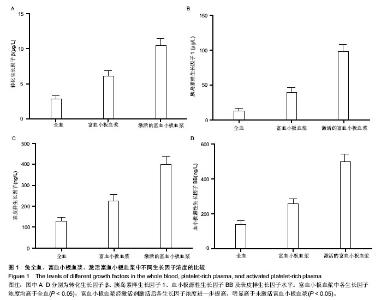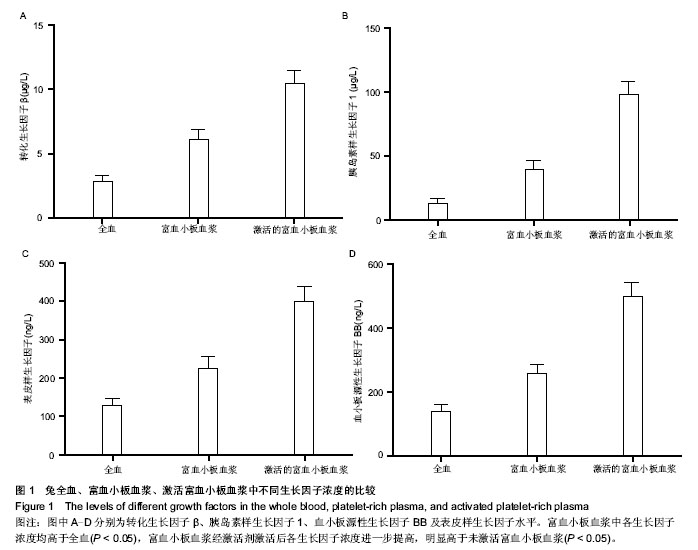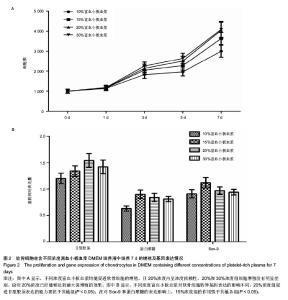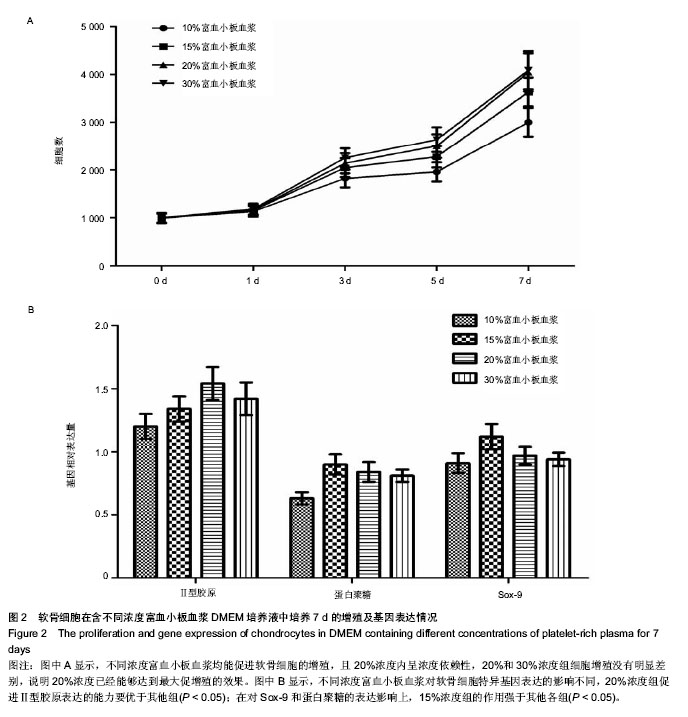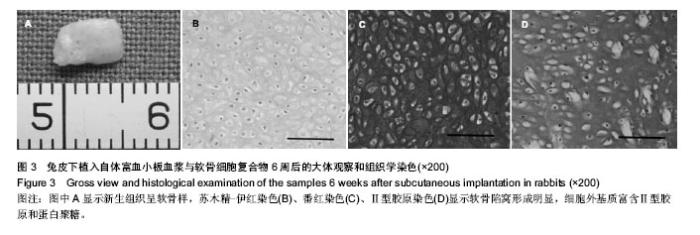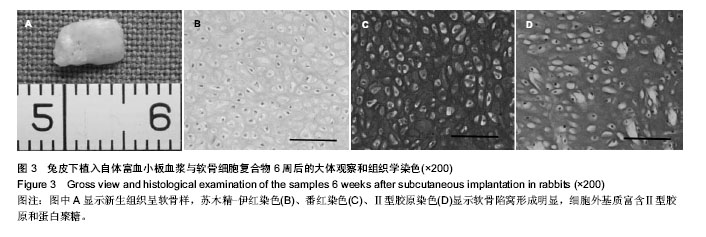Chinese Journal of Tissue Engineering Research ›› 2014, Vol. 18 ›› Issue (30): 4764-4770.doi: 10.3969/j.issn.2095-4344.2014.30.002
Previous Articles Next Articles
Platelet-rich plasma combined with chondrocytes for construction of injectable tissue-engineered cartilage
Wu Jun, Zhang Jun, Liu Jin-bo
- Department of Orthopedics, First People’s Hospital of Changzhou, Changzhou 213003, Jiangsu Province, China
-
Revised:2014-04-18Online:2014-07-16Published:2014-08-08 -
Contact:Liu Jin-bo, Chief physician, Department of Orthopedics, First People’s Hospital of Changzhou, Changzhou 213003, Jiangsu Province, China -
About author:Wu Jun, Studying for doctorate, Associate chief physician, Department of Orthopedics, First People’s Hospital of Changzhou, Changzhou 213003, Jiangsu Province, China -
Supported by:the Major Project of Changzhou Health Bureau, No. 2D2011008
CLC Number:
Cite this article
Wu Jun, Zhang Jun, Liu Jin-bo. Platelet-rich plasma combined with chondrocytes for construction of injectable tissue-engineered cartilage[J]. Chinese Journal of Tissue Engineering Research, 2014, 18(30): 4764-4770.
share this article
| [1] Raub CB,Hsu SC,Chan EF,et al.Microstructural remodeling of articular cartilage following defect repair by osteochondral autograft transfer. Osteoarthritis Cartilage.2013;21:860-868. [2] Wu J,Xue K,Li H,et al.Improvement of PHBV scaffolds with bioglass for cartilage tissue engineering.PLoS One. 2013;8: e71563. [3] Filardo G,Kon E,Andriolo L,et al.Clinical Profiling in Cartilage Regeneration: Prognostic Factors for Midterm Results of Matrix-Assisted Autologous Chondrocyte Transplantation.Am J Sports Med.2014.42(4):898-905. [4] Ko JY,Kim KI,Park S,et al.In vitro chondrogenesis and in vivo repair of osteochondral defect with human induced pluripotent stem cells.Biomaterials.2014;35(11):3571-3581. [5] Xue K,Qi L,Zhou G,et al.A two-step method of constructing mature cartilage using bone marrow-derived mesenchymal stem cells. Cells Tissues Organs.2013;197:484-495. [6] Xue K,Zhu Y,Zhang Y,et al.Xenogeneic chondrocytes promote stable subcutaneous chondrogenesis of bone marrow-derived stromal cells.Int J Mol Med.2012;29:146-152. [7] Levine DW,Roaf PL,Duguay SJ.Characterized chondrocyte implantation results in better structural repair when treating symptomatic cartilage defects of the knee in a randomized controlled trial versus microfracture. Am J Sports Med. 2009; 37:e3; author reply e4. [8] Saris DB,Vanlauwe J,Victor J,et al.Characterized chondrocyte implantation results in better structural repair when treating symptomatic cartilage defects of the knee in a randomized controlled trial versus microfracture. Am J Sports Med. 2008; 36: 235-246. [9] Blanke M,Carl HD,Klinger P,et al.Transplanted chondrocytes inhibit endochondral ossification within cartilage repair tissue. Calcif Tissue Int.2009;85:421-433. [10] Peffers MJ,Liu X,Clegg PD.Transcriptomic signatures in cartilage ageing. Arthritis Res Ther.2013;15:R98. [11] Li Y,Wei X,Zhou J,et al.The age-related changes in cartilage and osteoarthritis. Biomed Res Int.2013;2013:916530. [12] Sato M,Shin-ya K,Lee JI,et al.Human telomerase reverse transcriptase and glucose-regulated protein 78 increase the life span of articular chondrocytes and their repair potential. BMC Musculoskelet Disord.2012;13:51. [13] Cai L,Ye H,Yu F,et al.Effects of Bauhinia championii (Benth.) Benth.polysaccharides on the proliferation and cell cycle of chondrocytes.Mol Med Rep.2013;7:1624-1630. [14] Li Y,Qin J,Lin B,et al.The effects of insulin-like growth factor-1 and basic fibroblast growth factor on the proliferation of chondrocytes embedded in the collagen gel using an integrated microfluidic device.Tissue Eng Part C Methods. 2012;16:1267-1275. [15] Jonitz A,Lochner K,Tischer T,et al.TGF-β1 and IGF-1 influence the re-differentiation capacity of human chondrocytes in 3D pellet cultures in relation to different oxygen concentrations.Int J Mol Med.2012;30(6):666-672. [16] Chen Y,Ke J,Long X,et al.Insulin-like growth factor-1 boosts the developing process of condylar hyperplasia by stimulating chondrocytes proliferation.Osteoarthritis Cartilage. 2012;20: 279-287. [17] Kim HY,Park JH,Han YS,et al.The effect of platelet-rich plasma on flap survival in random extension of an axial pattern flap in rabbits. Plast Reconstr Surg.2013;132:85-92. [18] Browning SR,Weiser AM,Woolf N,et al.Platelet-rich plasma increases matrix metalloproteinases in cultures of human synovial fibroblasts.J Bone Joint Surg Am. 2012;94:e1721- 1727. [19] Yuan T,Guo SC,Han P,et al.Applications of leukocyte- and platelet-rich plasma(L-PRP) in trauma surgery.Curr Pharm Biotechnol.2012;13:1173-1184. [20] Lenza M,Ferraz Sde B,Viola DC,et al.Platelet-rich plasma for long bone healing. Einstein (Sao Paulo).2013;11:122-127. [21] Sommeling CE,Heyneman A,Hoeksema H,et al.The use of platelet-rich plasma in plastic surgery: a systematic review.J Plast Reconstr Aesthet Surg.2013;66:301-311. [22] Marx RE.Platelet-rich plasma: evidence to support its use.J Oral Maxillofac Surg.2004;62:489-496. [23] Alio JL,Arnalich-Montiel F,Rodriguez AE.The role of "eye platelet rich plasma" (E-PRP) forwound healing in ophthalmology.Curr Pharm Biotechnol.2012;13:1257-1265. [24] Kruger JP,Freymannx U,Vetterlein S,et al.Bioactive factors in platelet-rich plasma obtained by apheresis.Transfus Med Hemother.2013;40:432-440. [25] Perdisa F,Filardo G,Di Matteo B,et al.Platelet rich plasma: A valid augmentation for cartilage scaffolds? A systematic review. Histol Histopathol.2014.[Epub ahead of print] [26] Meretoja VV,Dahlin RL,Wright S,et al.Articular Chondrocyte Redifferentiation in 3D Co-cultures with Mesenchymal Stem Cells.Tissue Eng Part C Methods.2014 [27] Sato M,Yamato M,Hamahashi K,et al.Articular cartilage regeneration using cell sheet technology. Anat Rec (Hoboken).2013;297:36-43. [28] Eo SH,Cho H,Kim SJ.Resveratrol Inhibits Nitric Oxide-Induced Apoptosis via the NF-Kappa B Pathway in Rabbit Articular Chondrocytes. Biomol Ther (Seoul).2013; 21: 364-370. [29] Pirvu TN,Schroeder JE,Peroglio M,et al.Platelet-rich plasma induces annulus fibrosus cell proliferation and matrix production. Eur Spine J.2014;23(4):745-753. [30] Carneiro MD,Barbieri CH,Barbieri JN.Platelet-rich plasma gel promotes regeneration of articular cartilage in knees of sheeps. Acta Ortop Bras.2013;21:80-86. [31] Arnoczky SP,Shebani-Rad S.The basic science of platelet-rich plasma (PRP): what clinicians need to know. Sports Med Arthrosc.2013;21:180-185. [32] Ohba S,Wang W,Itoh S,et al.Efficacy of platelet-rich plasma gel and hyaluronan hydrogel as carriers of electrically polarized hydroxyapatite microgranules for accelerating bone formation.J Biomed Mater Res A.2012;100:3167-3176. [33] Chen W,Sun CC,Chen S,et al.A novel validated enzyme-linked immunosorbent assay to quantify soluble hemojuvelin in mouse serum. Haematologica. 2013;98: 296-304. [34] Liu D,Cui W,Liu B, et al.Atorvastatin Protects Vascular Smooth Muscle Cells From TGF-beta1-Stimulated Calcification by Inducing Autophagy via Suppression of the beta-Catenin Pathway.Cell Physiol Biochem. 2014;33: 129-141. [35] Feng ZY,He ZN,Zhang B,et al.Osteoprotegerin promotes the proliferation of chondrocytes and affects the expression of ADAMTS-5 and TIMP-4 through MEK/ERK signaling.Mol Med Rep.2013;8:1669-1679. [36] Ma WJ,Hashii M,Munesue T,et al.Non-synonymous single-nucleotide variations of the human oxytocin receptor gene and autism spectrum disorders: a case-control study in a Japanese population and functional analysis.Mol Autism. 2013;4:22. [37] Abd El Kader T,Kubota S,Nishida T,et al.The regenerative effects of CCN2 independent modules on chondrocytes in vitro and osteoarthritis models in vivo. Bone.2014; 59: 180-188. [38] Scala M,Mereu P,Spagnolo F,et al.The Use of Platelet-rich Plasma Gel in Patients with Mixed Tumour Undergoing Superficial Parotidectomy: A Randomized Study. In Vivo 2014;28(1):121-124. [39] Moo EK,Han SK,Federico S,et al.Extracellular matrix integrity affects the mechanical behaviour of in-situ chondrocytes under compression.J Biomech.2014.[Epub ahead of print] [40] Lopa S,Madry H .Bioinspired Scaffolds for Osteochondral Regeneration. Tissue Eng Part A.2014.[Epub ahead of print] [41] Yang HS,Shin J,Bhang SH,et al.Enhanced skin wound healing by a sustained release of growth factors contained in platelet-rich plasma.Exp Mol Med.2011;43(11):622-629. [42] Marx RE.Platelet-rich plasma: evidence to support its use. J Oral Maxillofacial Surg.2004;62:489-496. [43] Eppley BL,Woodell JE,Higgins J. Platelet quantification and growth factor analysis from platelet rich plasma: implications for wound healing. Plast Reconstr Surg. 2004;114(6): 1502-1508. [44] Akeda K,An HS,Okuma M,et al.Platelet-rich plasma stimulates porcine articular chondrocyte proliferation and matrix biosynthesis.Osteoarthritis Cartilage.2006;14(12): 1272-1280. [45] Drengk A,Zapf A,Stürmer EK,et al.Influence of platelet-rich plasma on chondrogenic differentiation and proliferation of chondrocytes and mesenchymal stem cells. Cells Tissues Organs.2009;189(5):317-326. [46] van der Kraan P,Vitters E,van den Berg W.Differential effect of transforming growth factor beta on freshly isolated and cultured articular chondrocytes.J Rheumatol. 1992;19(1): 140-145. [47] Fortier LA,Nixon AJ,Williams J,et al.Isolation and chondrocytic differentiation of equine bone marrow-derived mesenchymal stem cells.Am J Vet Res.1998; 59(9): 1182-1187. [48] Park SI,Lee HR,Kim S,et al.Time-sequential modulation in expression of growth factors from platelet-richplasma (PRP) on the chondrocyte cultures.Mol Cell Biochem. 2012;361(1-2): 9-17. |
| [1] | Sun Kexin, Zeng Jinshi, Li Jia, Jiang Haiyue, Liu Xia. Mechanical stimulation enhances matrix formation of three-dimensional bioprinted cartilage constructs [J]. Chinese Journal of Tissue Engineering Research, 2023, 27(在线): 1-7. |
| [2] | Zheng Hongrui, Zhang Wenjie, Wang Yunhua, He Bin, Shen Yajun, Fan Lei. Femoral neck system combined with platelet-rich plasma in the treatment of femoral neck fracture [J]. Chinese Journal of Tissue Engineering Research, 2023, 27(9): 1390-1395. |
| [3] | Huang Linke, Wei Linhua, Jiang Jie, Liu Qian, Chen Weiwei. Effects of estrogen combined with treadmill exercise on bone mass and articular cartilage in ovariectomized mice [J]. Chinese Journal of Tissue Engineering Research, 2023, 27(8): 1166-1171. |
| [4] | Lian Shilin, Zhang Yan, Jiang Qiang, Zhang Hanshuo, Li Tusheng, Ding Yu. Interventional effects of whole blood and platelet-rich plasma with different preparation methods on nucleus pulposus cells [J]. Chinese Journal of Tissue Engineering Research, 2023, 27(8): 1199-1204. |
| [5] | Xu Xingxing, Wen Chaoju, Meng Maohua, Wang Qinying, Chen Jingqiao, Dong Qiang. Carbon nanomaterials in oral implant [J]. Chinese Journal of Tissue Engineering Research, 2023, 27(7): 1062-1070. |
| [6] | Yang Yitian, Wang Lu, Yao Wei, Zhao Bin. Application of the interaction between biological scaffolds and macrophages in bone regeneration [J]. Chinese Journal of Tissue Engineering Research, 2023, 27(7): 1071-1079. |
| [7] | Li Cheng, Zheng Guoshuang, Kuai Xiandong, Yu Weiting. Alginate scaffold in articular cartilage repair [J]. Chinese Journal of Tissue Engineering Research, 2023, 27(7): 1080-1088. |
| [8] | Shi Yehong, Wang Cheng, Chen Shijiu. Early thrombosis and prevention of small-diameter blood vessel prosthesis [J]. Chinese Journal of Tissue Engineering Research, 2023, 27(7): 1110-1116. |
| [9] | Tang Haotian, Liao Rongdong, Tian Jing. Application and design of piezoelectric materials for bone defect repair [J]. Chinese Journal of Tissue Engineering Research, 2023, 27(7): 1117-1125. |
| [10] | Xu Yan, Li Ping, Lai Chunhua, Zhu Peijun, Yang Shuo, Xu Shulan. Piezoelectric materials for vascularized bone regeneration [J]. Chinese Journal of Tissue Engineering Research, 2023, 27(7): 1126-1132. |
| [11] | Li Xinyue, Li Xiheng, Mao Tianjiao, Tang Liang, Li Jiang. Three-dimensional culture affects morphology, activity and osteogenic differentiation of human periodontal ligament stem cells [J]. Chinese Journal of Tissue Engineering Research, 2023, 27(6): 846-852. |
| [12] | Li Xiaoyin, Yang Xiaoqing, Chen Shulian, Li Zhengchao, Wang Ziqi, Song Zhen, Zhu Daren, Chen Xuyi. Collagen/silk fibroin scaffold combined with neural stem cells in the treatment of traumatic spinal cord injury [J]. Chinese Journal of Tissue Engineering Research, 2023, 27(6): 890-896. |
| [13] | Yuan Bo, Xie Lide, Fu Xiumei. Schwann cell-derived exosomes promote the repair and regeneration of injured peripheral nerves [J]. Chinese Journal of Tissue Engineering Research, 2023, 27(6): 935-940. |
| [14] | Qin Yuxing, Ren Qiangui, Li Zilong, Quan Jiaxing, Shen Peifeng, Sun Tao, Wang Haoyu. Action mechanism and prospect of bone microvascular endothelial cells for treating femoral head necrosis [J]. Chinese Journal of Tissue Engineering Research, 2023, 27(6): 955-961. |
| [15] | Xiong Bohan, Yu Yang, Lu Xiaojun, Wang Xu, Yang Tengyun, Zhang Yaozhang, Liao Xinyu, Zhou Xiaoxiang, He Lu, Li Yanlin. Research progress in promoting tendon to bone healing during anterior cruciate ligament reconstruction [J]. Chinese Journal of Tissue Engineering Research, 2023, 27(5): 779-786. |
| Viewed | ||||||
|
Full text |
|
|||||
|
Abstract |
|
|||||
